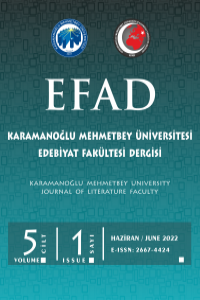Sineklerin Tanrısı ve Huckleberry Finn'in Maceraları’ndaki Yeni Çocuk İmgesi
Edebi eserlerdeki stereotipik karakterlerin özellikleri, zamanla toplum içerisinde temsil ettikleri grubun taşıdığı özelliklerin değişmesiyle değişime uğrayabilir. Bu değişimi en çok yaşayanlardan biri çocuk imgesidir. Önceleri küçük bir yetişkin, doğuştan kötü ya da kalıba sokulacak bir balmumu olarak görülen çocuk, zamanla daha karmaşık ve incelikli tasvirler içerecek şekilde değişmiştir çünkü gerçek dünyadaki çocuk eskisinden farklı görülmeye başlanmış ve göründüğünden daha karmaşık bir yapıya sahip olduğunun farkına varılmıştır. Bu durum, çocukların birbirlerine son derece benzeyen, ortak özelliklere ve davranışlara sahip yekpare bir gruptan ibaret olmadığının göstergesidir. Doğa, toplum ve yaşam koşulları gibi faktörler her çocuğun kendine özgü karakterinin ve eylemlerinin şekillenmesinde önemli rol oynar ve bu nedenle bir çocuk yalnızca iyi, kötü, saf veya kusurlu olamaz. Ancak her durumda çocuk imgesi, toplumun istek ve beklentilerine göre şekillenir. Özetlemek gerekirse, geçmişten günümüze çocuklar stereotiplerden ziyade, çok boyutlu bireyler olarak anlaşılmaya başlanmış ve bunun edebiyattaki tezahürü olarak da eserlerde daha karmaşık şekilde temsil edilmeye başlanmıştır. Bu değişim süreci önceki edebi dönemler ve onlara nazaran daha yeni olan Huckleberry Finn'in Maceraları ve Sineklerin Tanrısı romanları incelendiğinde açıkça görülmektedir.
Anahtar Kelimeler:
Değişim, Çocuk İmgesi, Stereotip, Edebiyat, Toplumun İstek ve Beklentileri
New Image of the Child in Lord of the Flies and the Adventures of Huckleberry Finn
The characteristics of stereotypical characters in literary works may transform over time as the characteristics of the group they represent in society change. Child image is one of those which experiences this change the most. Child, who initially appeared as a little adult, evil born or wax to be molded, has evolved to include more complex and sophisticated depictions because the child in the real world has begun to be seen differently than before and it has been understood that it has a more complex structure than it appears. This indicates that children are not just a monolithic group who look remarkably alike and have common characteristics and behaviors. Factors such as nature, society, and living conditions play an important role in shaping each child's unique character and actions, and therefore a child cannot be exclusively decent, evil, pure, or tainted. However, in any case, the image of the child is shaped by the wishes and expectations of society. To make a long story short, from the past to the present, children have come to be understood as more than stereotypes and as multidimensional individuals, and as a manifestation of this in literature, they have begun to be represented more complexly in works. This process of change is evident when the older literary periods and more recent novels The Adventures of Huckleberry Finn and Lord of the Flies are analyzed.
Keywords:
Change, Child Image, Stereotype, Literature, Wishes and Expectations of Society,
___
- Altunay, T. A. (2005). The myth of childhood in English Romantic poetry. Unpublished Master’s Thesis. Dumlupınar University, Kütahya. https://tezarsivi.com/the-myth-of-childhood-in-english-romantic-poetry
- Anandalakshmy, S., & Grinder, R. E. (1970). Conceptual emphasis in the History of Developmental Psychology: Evolutionary Theory, Teleology, and the Nature-Nurture Issue. Child Development, 41(4), 1113–1123. DOI: https://doi.org/10.2307/1127338
- Austin, L. M. (2003). Children of Childhood: Nostalgia and the Romantic Legacy. Studies in Romanticism, 42(1), 75–98. DOI: https://doi.org/10.2307/25601604
- Blake, W., Erdman, D., & Bloom, H. (2008). The Complete Poetry and Prose of William Blake: With a New Foreword and Commentary by Harold Bloom (First). Oakland, California, University of California Press.
- Crane, G. (2007). The Cambridge Introduction to The Nineteenth-Century American Novel. Cambridge, United Kingdom, Cambridge University Press.
- Gelbert, M. M. (1974). The notion of the child in the poetry of Wordsworth: Correspondences in Blake and Rousseau. Unpublished Master’s Thesis. University of Ottawa. Canada. DOI: https://doi.org/10.20381/ruor-17846
- George, U. (2008). William Golding: A Critical Study. New Delhi, India, Atlantic Publishers & Dist.
- Gill, S. (2010). William Wordsworth: 21st-Century Oxford Authors (1st ed.). Oxford, United Kingdom, Oxford University Press.
- Golding, W. (1954/2012). Lord of the Flies. London, United Kingdom, Faber and Faber.
- Goldstone, B. P. (1986). Views of childhood in children’s literature over time. Language Arts, 63(8), 791–798. DOI: http://www.jstor.org/stable/41405515
- Lackey, M. (2002). Beyond good and evil: Huckleberry Finn on human intimacy. Amerikastudien/ American Studies, 47(4), 491–501.
- Meibauer, B., Gillespie, G., Engel, M. & Dieterle, B. (2008). Romantic prose fiction. Amsterdam, Netherland, John Benjamins Publishing.
- Rice, C. (1937). The soul of a child. Blackfriars, 18(206), 372–375. http://www.jstor.org/stable/43810857
- Robinson, F.G. (1988). The characterization of Jim in Huckleberry Finn. Nineteenth-Century Literature, 43(3), 361-391). http://www.jstor.org/stable/3044898
- Sky, J. (2002). Myths of innocence and imagination: The case of the fairy tale. Literature and Theology, 16(4), 363–376. http://www.jstor.org/stable/23926824
- Twain, M. (1885/1994). The Adventures of Huckleberry Finn. London, United Kingdom, Penguin.
- Yayın Aralığı: Yılda 2 Sayı
- Başlangıç: 2018
- Yayıncı: Karamanoğlu Mehmetbey Üniversitesi
Sayıdaki Diğer Makaleler
Sosyal Bilgiler Öğretmen Adaylarının Günümüz Dünya Sorunları Hakkında Durumları ve Görüşleri
Hapishanede Kadın Olmak: Gülsün Karamustafa’nın Mahkûm Kadınları
Bozkır Barajı Havzasında Yer Alan Köylerde Bitki Adlarından Oluşan Yer Adları
Niğde Müzesi Tyana Darplı Roma İmparatorluk Dönemi Sikkeleri
Halime Yücel, (2021) İmgeden Yoruma
Bir Vapurunun Hazin Sonu: Teksas Vapuru Kazası (1912)
Nazli GÜNDÜZ, Aslı Nur KAHRAMAN, Sinem Begüm KARAKUŞ, Yaren ÖZDEĞER
Sineklerin Tanrısı ve Huckleberry Finn'in Maceraları’ndaki Yeni Çocuk İmgesi
Çin’de bir Osmanlı, Nusret Ali Han Dehlevi ve ‘Çin Maçin’ Adlı Eseri (1901)
